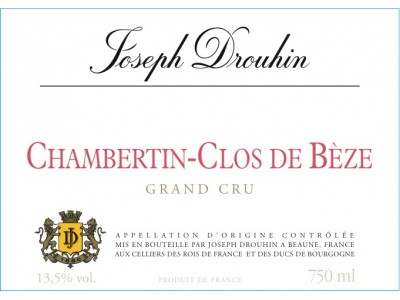
Chambertin Clos de BèzeJoseph Drouhin
- Production region Côte de Nuits
- Color Red
- Classification Grand Cru
- Vintage 2019

Grape Variety : Pinot Noir.
Vineyard :
Site: the Grand Cru vineyard of Chambertin-Clos de Bèze is found in the northern part of the Côte de Nuits. It occupies a choice location with its exposure to the east and its mild incline.
History & tradition: the monks from the Abbey of Bèze became owners of vineyards in Gevrey as early as 630AD. They cultivated this vineyard and built a wall around it which is no longer extant today.
Soil: a mix of red clay, chalk and broken stones.
Drouhin estate: 0,13 ha. (0.325 acre).
Average age of the vines: replanted.
Viticulture :
Biological cultivation since 1990; biodynamic cultivation a few years later.
Vine stocks: "sélection massale" (propagation of new vine stocks from a number of selected vines) done at the Drouhin nursery; also clones of recognized quality.
Soil maintenance: compost of manure and white wood, sometimes guano (seabird manure used as fertilizer). Soil is ploughed either by tractor or by horse to manage spreading of weeds.
Treatment: only authorized products for biological cultivation are used: infusions and macerations of plant materials, sulfur and copper, powdered rock. Natural predators are not eliminated.
Plantation density: from 10,000 to 12,500 stocks/ha in order to extract all possible nuances from the terroir and limit the production of each vine stock.
Pruning: Guyot.
Yield: we aim to keep our yields low, more in line with the previous regulation: around 20% less than allowed by the current law.
Vinification :
Harvesting: by hand, in small open crates in order to preserve the integrity of the fruit.
Sorting of the grapes: in the vineyard and at the cuverie (winery) if necessary.
Maceration:
maceration and vinification take 2 to 3 weeks indigenous yeastsmaceration and fermentation temperatures under total control.Joseph Drouhin seeks total control of the process of extraction; extraction gives colour and substance to a wine but should never be detrimental to its finesse and typical character.
"Pigeage" (punching down of the cap during fermentation): once a day until half of fermentation is done; one pumping over ("remontage") per day till the end of the fermentation.
Pressing: separation of free run juice from pressed juice.
Ageing :
Type: in barrels (20% in new oak)
Length: 14 to 18 months.
Origin of the wood: French oak forests.
Weathering of the wood: Joseph Drouhin insists on total control of the weathering for a period of 3 years, one of the contributing elements to the elegance of the wine.
Follow-up: barrel by barrel.
Fining (collage, to clarify the wine): light, after careful tasting.
Throughout the ageing process, decisions are taken only after careful tasting evaluation, barrel by barrel. The data obtained is then completed through technical analysis. As with every other Joseph Drouhin wine, absolute priority is given to the true expression of terroir and character of the vintage.
Tasting note by Véronique Boss-Drouhin :
"A beautiful, intense ruby-red colour. Powerful but refined aromas. When the wine is young, the aromas are reminiscent of black cherry and dark chocolate. With age, they evolve towards notes of undergrowth, truffle and liquorice. After 15 years or so, the aromas of candied fruit remain but are mingled with nuances of leather and musk. Tannins provide a good structure, perfectly balanced by the velvety texture of the wine. The long aftertaste brings back the aromas of cherry and liquorice: a kaleidoscope of sensations".
Tasting note by Véronique Boss-Drouhin : "A beautiful, intense ruby-red colour. Powerful but refined aromas. When the wine is young, the aromas are reminiscent of black cherry and dark chocolate. With age, they evolve towards notes of undergrowth, truffle and liquorice. After 15 years or so, the aromas of candied fruit remain but are mingled with nuances of leather and musk. Tannins provide a good structure, perfectly balanced by the velvety texture of the wine. The long aftertaste brings back the aromas of cherry and liquorice: a kaleidoscope of sensations".
Serving :
Temperature: 16-18°C (61-65°F).
Cellaring: 10 to 40 years.

Address:Maison Denis Perret
Place Carnot
21200 Beaune
Phone:+33(0)3.80.22.35.47
contact@denisperret.frhuston we have a problem